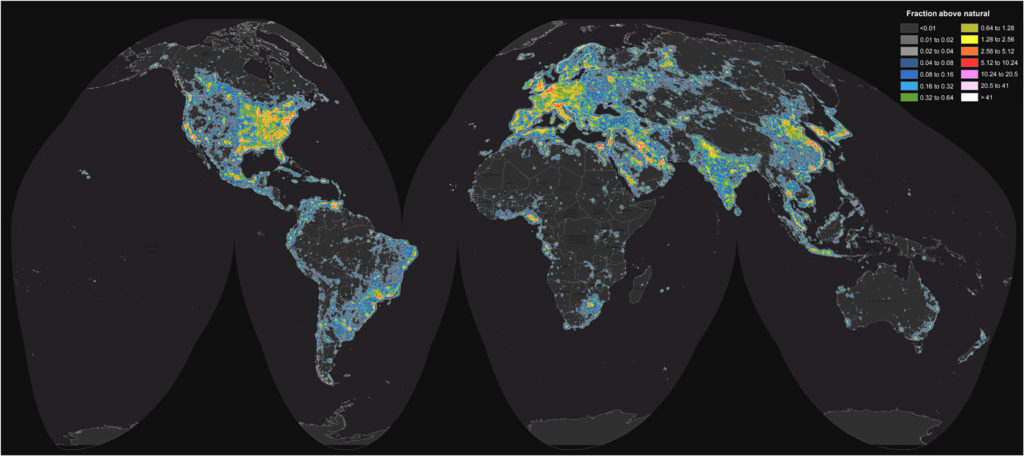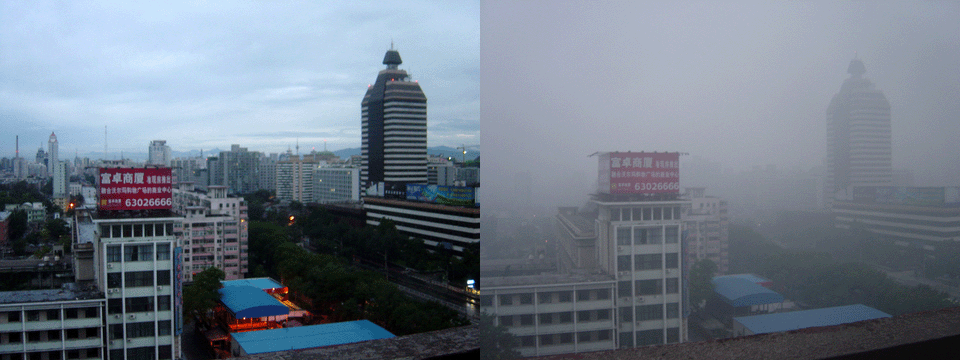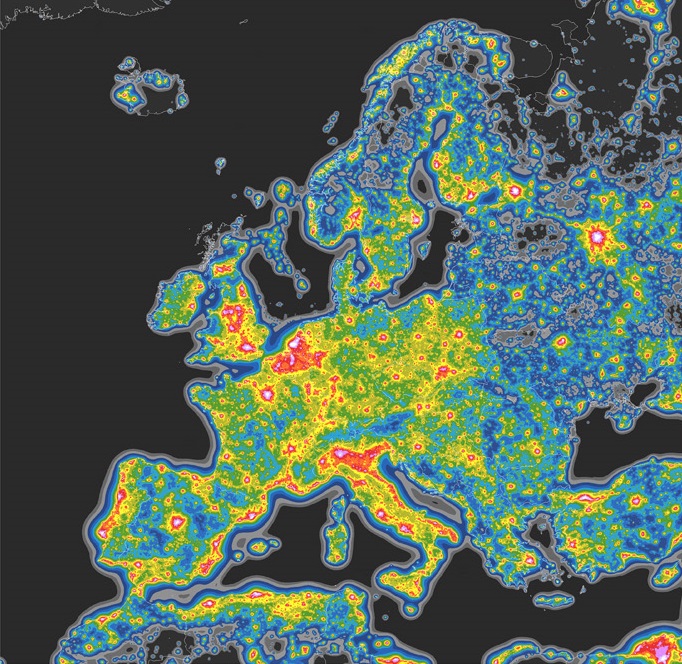Light pollution is a problem that is becoming more and more important because, as research on the subject evolves, the alteration of light levels during the night has an effect on people that can go far beyond preventing us from seeing the starry sky.
We will now discuss some of the causes, consequences and possible solutions to this type of pollution, which is so prevalent in the most developed countries.

What is light pollution?
We can define light pollution as the presence of artificial light that generates a degradation in the natural state of the environment. An alternative definition only considers as a pollutant the light whose characteristics or time of operation are unnecessary to carry out the activities in the area where the lights are installed.
Considering this second definition, only inefficient lighting would be polluting. On the other hand, for the first definition, almost any light source is a pollutant. For this reason, in the field of engineering, the second definition is used because it is about minimizing the impact of lighting on the environment.
What is undeniable is that light pollution is a side effect inherent to civilization itself.
| Ratio to natural brightness | Artificial brightness (μcd/m²) | Total brightness (mcd/m²) | Color |
| <0.01 | <1.74 | <0.176 | |
| 0.01-0.02 | 1.74-3.48 | 0.176-0.177 | |
| 0.2-0.04 | 3.48-6.96 | 0.177-0.181 | |
| 0.04-0.08 | 6.96-13.9 | 0.181-0.188 | |
| 0.08-0.16 | 13.9-27.8 | 0.188-0.202 | |
| 0.16-0.32 | 27.8-55.7 | 0.202-0.230 | |
| 0.32-0.64 | 55.7-111 | 0.230-0.285 | |
| 0.64-1.28 | 111-223 | 0.285-0.397 | |
| 1.28-2.56 | 223-445 | 0.397-0.619 | |
| 2.56-5.12 | 445-890 | 0.619-1.07 | |
| 5.12-10.2 | 890-1780 | 1.07-1.96 | |
| 10.2-20.5 | 1780-3560 | 1.96-3.74 | |
| 20.5-41 | 3560-7130 | 3.74-7.30 | |
| >41 | >7130 | >7.30 |
Types of light pollution
Although we speak of light pollution, we are referring to a very broad term that encompasses a variety of issues. Each type of light pollution has its own specific causes and consequences.
Light intrusion
The most common example of this type of problem is light entering a house from a street lamp. This light can cause significant discomfort, especially when it comes to falling asleep.
Overlighting
A problem largely ignored until the end of the 20th century. It consists of lighting with a higher intensity than is necessary for the activities to be carried out in the space.
Glare
A phenomenon that makes vision difficult in the presence of a powerful light source. When we talked about the UGR(Unified Glare Index) we already detailed the types of glare that exist and their causes.
Excessive light clustering
This type of light clustering is a source of distraction and confusion. They can even distract the attention of those who are illuminating.
Consequences
Light pollution has a series of effects on the environment, among which the following stand out.
Increased pollution
As a study by the American Geophysical Union reveals , the part of the light that is projected into the sky at night destroys a type of nitrogen oxide, the nitrogen radical.

This substance intervenes in certain chemical reactions that occur in the atmosphere and contribute to eliminating what is known as Smog (phonetic adaptation of the English acronym Smog, which comes from smoke and fog ) or smog.
Health effects
We have already talked on other occasions about how poor lighting was linked to ailments such as Seasonal Affective Disorder (SAD).
Excessive light during the night inhibits some functions of the pineal gland, such as melatonin secretion, which is essential for the regulation of circadian rhythms.
In addition to sleep problems, other health effects include headaches, stress, fatigue and anxiety.
Astronomy
This science is very sensitive to light pollution. This is because the brightness of the sky, which increases with pollution, reduces the contrast of stars and galaxies with the sky itself.
This makes it much more difficult for telescopes to work efficiently and is the reason why they are installed in increasingly remote areas.
Disruption of ecosystems
Like people, animals of all kinds are affected by light pollution.
Animals that are less light tolerant are at a disadvantage when it comes to such essential activities as feeding and reproduction. For example, an animal that feeds on insects and tolerates light well will have a better chance of hunting if it is placed next to a light source because it will attract the insects.
A very curious case is that of zooplankton that exhibit what is known as vertical daily migration. This is a pattern of displacement by which some marine species move vertically in the water depending on the existing light.
In the case of zooplankton, they move at night towards the surface as their predators (small fish) detect them visually during the day. If there is light during the night, they stay deeper and this benefits the proliferation of phytoplankton, which is the zooplankton food. The increase in the phytoplankton population favors the appearance of algae that end up impoverishing the quality of the water.

Reduction of sky polarization
The polarization of the sky when illuminated by the moon is drastically reduced by the presence of light pollution.
Although this polarization of moonlight is not visible to the human eye, it is believed within the scientific community that some animals use it as a navigation system.
Energy waste
A more than obvious consequence of excessive lighting is the cost overruns for companies, individuals and public entities.
Nowadays we can use technologies such as LED lighting that allow us to reduce consumption, but if we adjust the lighting levels of spaces to their real needs, the savings could be much greater.
Solutions to light pollution
Awareness is essential so that the effects of light pollution can be reduced as much as possible without harming the proper lighting of any space.
We can focus on four fundamental aspects when designing lighting systems in the most efficient and ecological way possible.
Limiting direct luminous flux
In this case it would be sufficient to limit the amount of light to the safety levels that organizations such as the CIE (International Commission on Illumination) and of which we have already spoken on occasion.
Minimizing the FHSinst
The FHSinst (Upper Hemispherical Flux Installed) is defined as the percentage of a luminaire’s flux that is emitted on the horizontal plane. This is, in short, the percentage of light that is projected towards the sky.
By limiting this value it is possible to reduce light pollution significantly. For example, a luminaire with FHSinst = 3% emits 290% more glare at 200km than one with a value close to 0%.
Use efficient lighting
Opt for energy-efficient technologies such as LEDs, which generate more directional light sources and have a lower environmental impact.
Lighting automation
A more intelligent and automated management of lighting on/off and light intensity would make it possible to dynamically adjust the available light to the real needs of each moment.
This would include tasks such as selective switching off of public, ornamental and advertising lighting or reducing the flow of light at certain times.

Now that we know a little more about how light pollution affects us, it is time to do our bit to reduce it. In other blog articles we have already told you some tricks on how to save energy that can help to protect the environment and, incidentally, save a few euros each month.
As a curiosity and to finish we leave you a fully interactive pollution map. With it you can investigate the levels of light pollution anywhere in the world.

